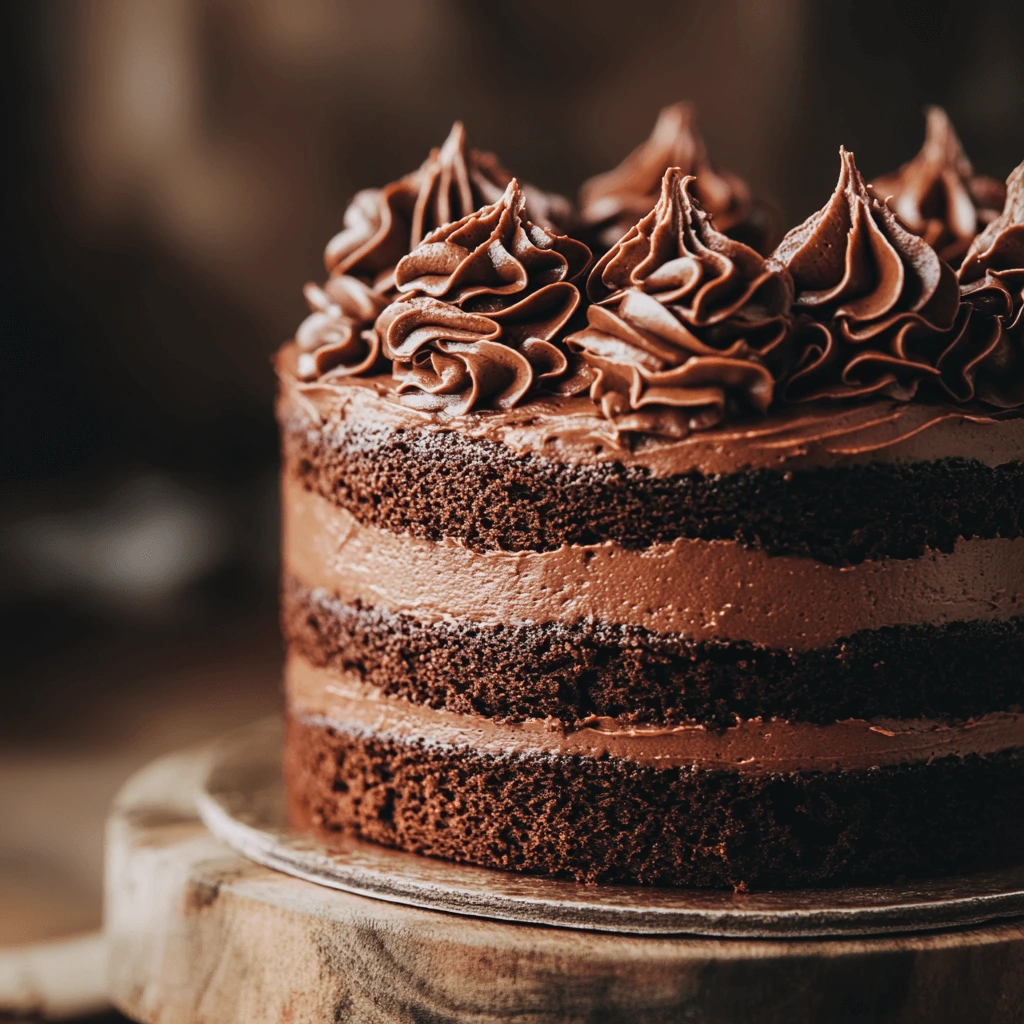The Importance of Moisture in the Best Chocolate Cake Recipe
When it comes to baking the perfect chocolate cake, moisture plays a critical role in determining the final texture and flavor. A dry cake simply won’t provide the satisfying, indulgent experience that a moist one does. Achieving the right moisture balance is key to a chocolate cake that’s soft, tender, and full of flavor. In this section, we’ll explore the importance of moisture and how it directly impacts your cake’s outcome.
Print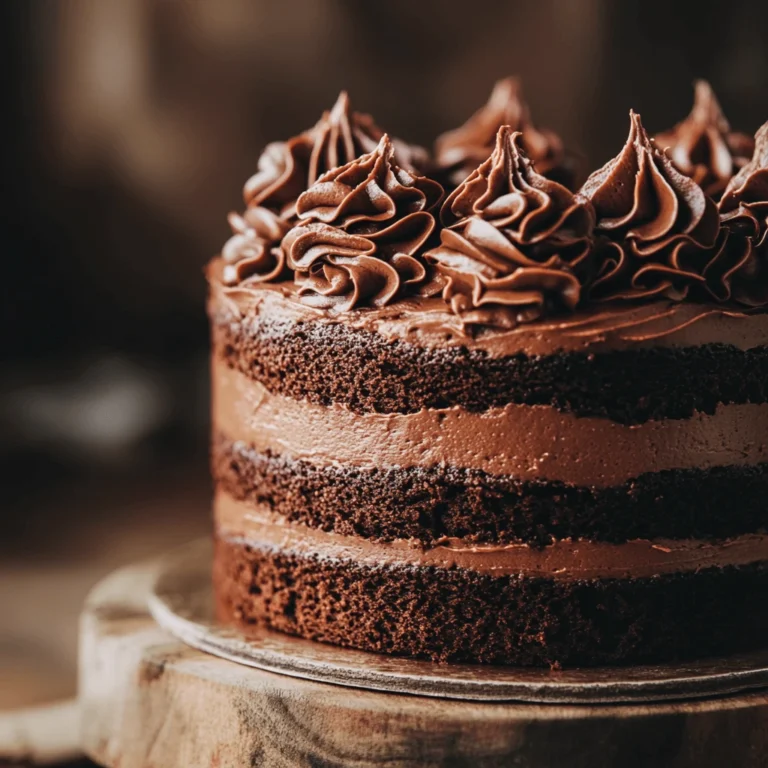
Moist Chocolate Cake Recipe
This moist chocolate cake is rich, tender, and full of flavor. Perfect for any occasion, it’s made with the ideal balance of ingredients to ensure maximum moisture and a melt-in-your-mouth texture.
- Total Time: 50 minutes
- Yield: 8 servings 1x
Ingredients
- 1 1/2 cups (190g) all-purpose flour
- 1 1/2 teaspoons baking powder
- 1/2 teaspoon baking soda
- 1/2 teaspoon salt
- 3/4 cup (75g) unsweetened cocoa powder (preferably Dutch-processed)
- 1 cup (200g) granulated sugar
- 1/2 cup (100g) brown sugar, packed
- 2 large eggs
- 1/2 cup (120ml) vegetable oil (or any neutral oil)
- 1 cup (240ml) whole milk (or buttermilk for extra moisture)
- 1 teaspoon vanilla extract
- 1/2 cup (120g) sour cream (for moisture and richness)
- 1 cup (240ml) boiling water (for a moist and tender crumb)
- 1/2 cup (120ml) hot brewed coffee (optional, enhances chocolate flavor)
Instructions
- Preheat your oven to 350°F (175°C).
- In a large bowl, combine the flour, baking powder, baking soda, salt, and cocoa powder.
- In a separate bowl, whisk together the sugar, brown sugar, eggs, oil, milk, vanilla extract, and sour cream until smooth.
- Gradually add the wet ingredients to the dry ingredients, stirring until just combined.
- Slowly add the boiling water (and coffee if using) to the batter, mixing until smooth.
- Pour the batter into a greased and floured cake pan.
- Bake for 30-35 minutes or until a toothpick inserted into the center comes out clean.
- Allow the cake to cool completely before frosting.
Notes
For extra moisture, you can use buttermilk instead of regular milk, and adding coffee brings out the richness of the chocolate.
- Prep Time: 15 minutes
- Cook Time: 35 minutes
- Category: Dessert
- Method: Baked
- Cuisine: American
Nutrition
- Serving Size: 1 slice
- Calories: 350
- Sugar: 30g
- Sodium: 200mg
- Fat: 18g
- Saturated Fat: 8g
- Unsaturated Fat: 9g
- Trans Fat: 0g
- Carbohydrates: 45g
- Fiber: 4g
- Protein: 5g
- Cholesterol: 55mg
Keywords: chocolate cake, moist cake, chocolate, dessert, baking
How Moisture Affects Chocolate Cake
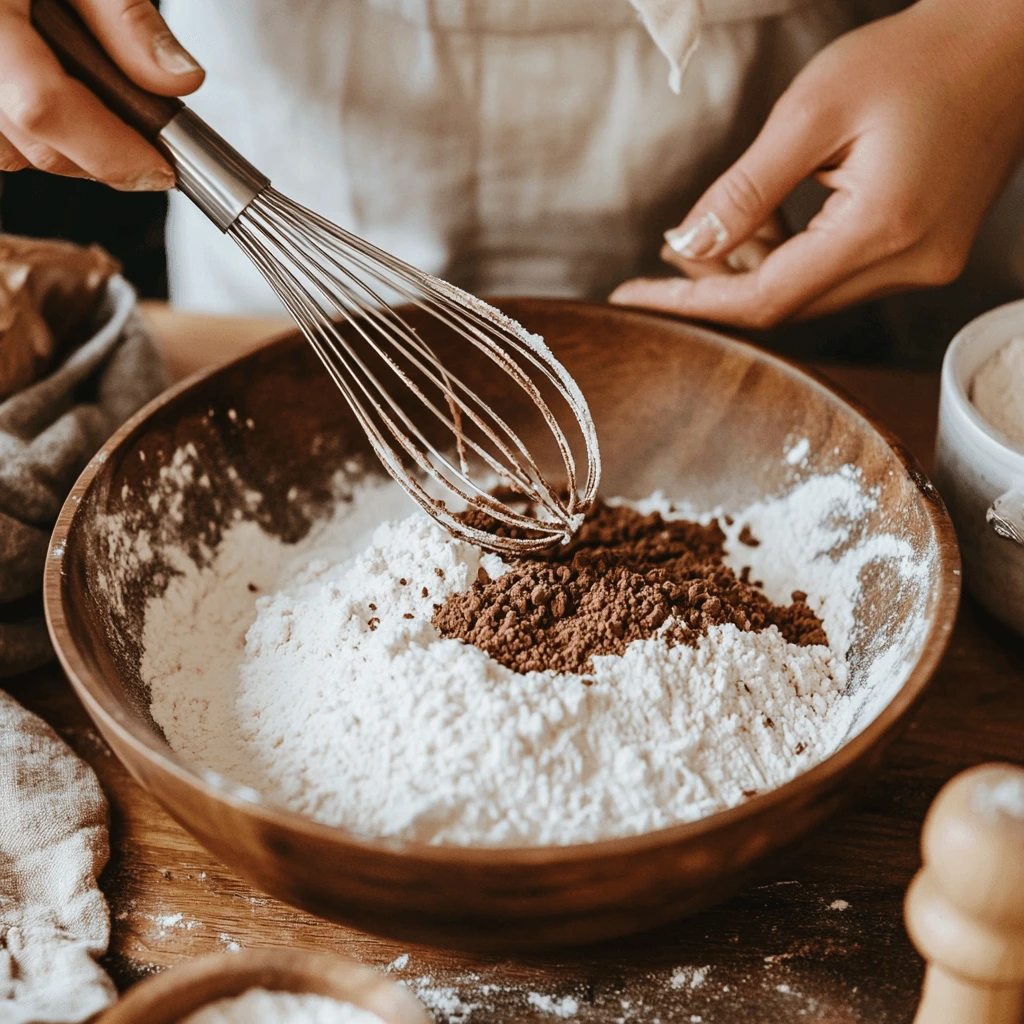
The moisture in a chocolate cake influences more than just its texture; it affects how the cake holds together, its tenderness, and how rich it feels when you take a bite. A well-moisturized cake will remain soft for longer, while a dry one can become stale within hours. If a cake lacks enough moisture, it can end up being dense and crumbly, which is far from the ideal result.
For the best results, moisture must be evenly distributed throughout the cake batter. This means incorporating the right wet ingredients, such as milk, sour cream, or buttermilk, and choosing fats that contribute to tenderness, like oil or butter. Understanding how moisture works in the cake-making process is the first step toward baking the perfect chocolate cake.
Choosing the Right Ingredients for Moisture
The ingredients you select can make all the difference when it comes to creating a moist chocolate cake. Fats like butter and oil, dairy products like milk or sour cream, and even simple syrup all contribute to the moisture of the final product. The type of flour you use also matters; for example, cake flour, with its lower protein content, yields a softer, more tender crumb compared to all-purpose flour.
Incorporating moisture-retaining ingredients is especially important for cakes that need to be stored or transported. Ingredients like buttermilk or sour cream not only add flavor but also keep your cake moist for a longer time. When baking, it’s crucial to follow the right ingredient proportions and ensure they work in harmony to create a cake that’s perfectly moist.
The Role of Butter and Oil in a Moist Chocolate Cake
When you bake a chocolate cake, one of the most important decisions is whether to use butter, oil, or a combination of both. Both ingredients contribute moisture, but in different ways. Understanding their roles can help you achieve the perfect texture and flavor in your cake. In this section, we will dive into the differences between butter and oil, and how to use them effectively in your chocolate cake recipe.
Butter vs. Oil: Which is Better for Moisture?
Butter and oil are both fats that contribute to the moisture of your cake, but they each have unique qualities. Butter adds flavor and richness to a chocolate cake. It creates a slightly denser texture, while still keeping the cake moist. On the other hand, oil produces a lighter, more tender cake because it is liquid at room temperature. Oil also tends to keep cakes moist longer, as it doesn’t solidify like butter does when cooled.
In general, oil is more effective at retaining moisture in a chocolate cake than butter, making it an ideal choice if you’re aiming for a super moist cake. However, many bakers combine both butter and oil in their chocolate cake recipes to enjoy the best of both worlds: the rich flavor of butter and the moisture-locking properties of oil.
How Much Fat is Necessary for the Best Chocolate Cake Recipe?
The amount of fat used in your chocolate cake recipe is key to ensuring it’s moist but not greasy. Too little fat can result in a dry, crumbly cake, while too much can make it heavy or greasy. The right amount of fat helps achieve the perfect balance of moisture and tenderness.
For most chocolate cake recipes, a combination of around 1 to 1 1/4 cups of fat (either butter, oil, or a mix of both) is ideal. Keep in mind that the other ingredients, such as eggs, milk, or sour cream, also contribute to the cake’s moisture. It’s important to follow the specific measurements in the recipe to ensure the proper texture and moisture content.
Table of Contents
Table of Contents
The Secret Ingredients That Make Chocolate Cake Moist
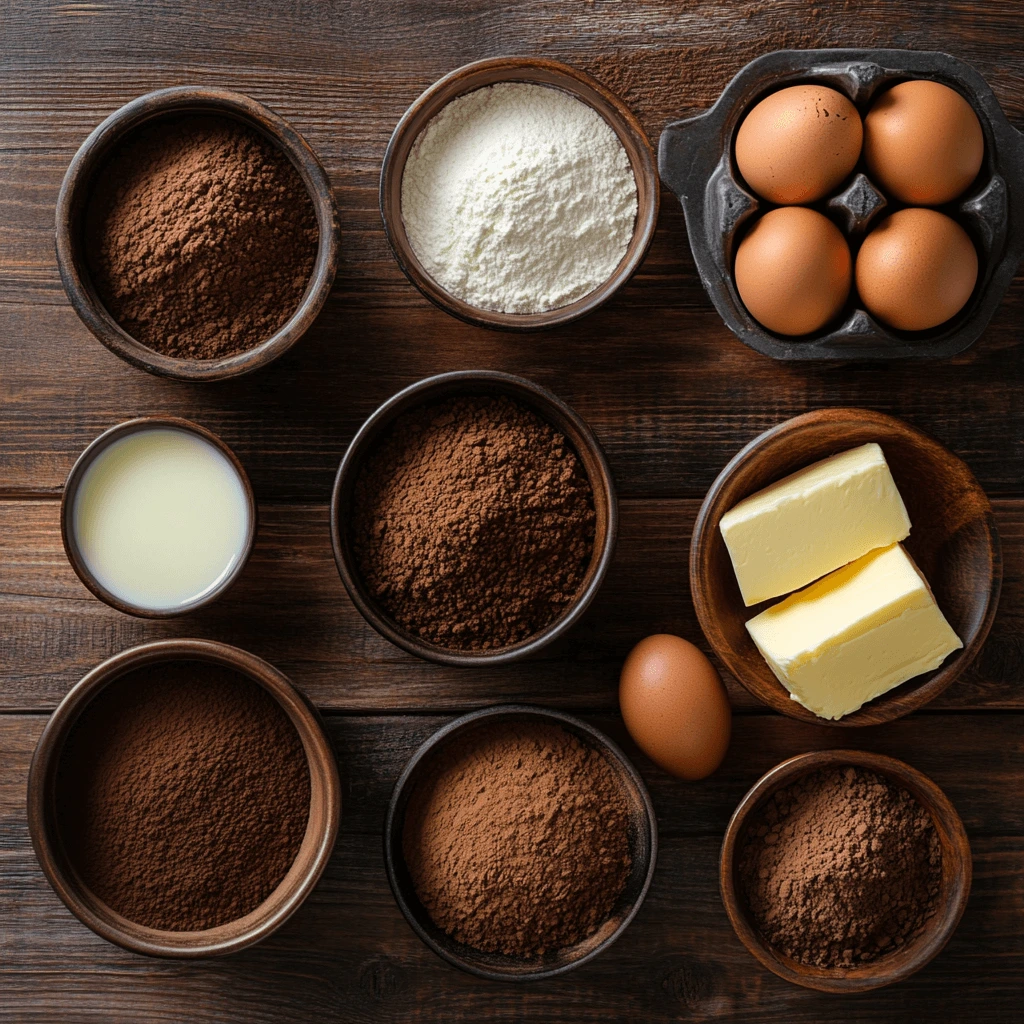
Ingredients for the Best Moist Chocolate Cake:
- 1 1/2 cups (190g) all-purpose flour
- 1 1/2 teaspoons baking powder
- 1/2 teaspoon baking soda
- 1/2 teaspoon salt
- 3/4 cup (75g) unsweetened cocoa powder (preferably Dutch-processed)
- 1 cup (200g) granulated sugar
- 1/2 cup (100g) brown sugar, packed
- 2 large eggs
- 1/2 cup (120ml) vegetable oil (or any neutral oil)
- 1 cup (240ml) whole milk (or buttermilk for extra moisture)
- 1 teaspoon vanilla extract
- 1/2 cup (120g) sour cream (for moisture and richness)
- 1 cup (240ml) boiling water (for a moist and tender crumb)
- 1/2 cup (120ml) hot brewed coffee (optional, enhances chocolate flavor)
Achieving the perfect moisture in a chocolate cake often involves incorporating a few secret ingredients that help lock in the moisture and add richness. These ingredients work wonders in preventing the cake from becoming dry, and they can also add depth to the flavor. Let’s take a look at two key ingredients that contribute to the moistness of your chocolate cake: sour cream and buttermilk.
Adding Sour Cream for Extra Moisture
Sour cream is a fantastic ingredient to include in chocolate cake recipes if you want to ensure that your cake stays moist and tender. The high fat content in sour cream helps retain moisture, resulting in a cake that’s soft and rich. Additionally, the acidity in sour cream interacts with baking soda to create a fluffier texture. The slight tang from the sour cream also adds an extra layer of flavor that complements the chocolate without overpowering it.
For a perfectly moist cake, consider adding about half a cup of sour cream to your batter. This simple addition will work wonders for both the texture and taste of your chocolate cake, giving it the perfect balance of moisture and flavor.
Using Buttermilk for a Softer, Moist Cake
Buttermilk is another secret ingredient that adds moisture to your chocolate cake. Like sour cream, buttermilk has a slightly acidic nature that reacts with the baking soda to create a light and airy texture. The moisture from the buttermilk helps keep the cake soft and tender even after it has cooled. It also adds a subtle, slightly tangy flavor that enhances the richness of the chocolate.
Buttermilk can be used as a substitute for regular milk in most chocolate cake recipes. If your recipe calls for 1 cup of milk, swap it for 1 cup of buttermilk. This small change can significantly improve the cake’s texture, making it moist and soft without being overly dense.
How to Incorporate Cocoa Powder for Maximum Flavor and Moisture
Cocoa powder is the heart and soul of any great chocolate cake. It not only provides the rich chocolate flavor but also contributes to the moisture content when used correctly. However, not all cocoa powders are created equal, and how you incorporate it into your batter plays a significant role in achieving the perfect cake texture.
Choosing the Best Cocoa Powder for Rich Flavor
The quality of cocoa powder you choose directly affects the flavor and moisture of your chocolate cake. Natural cocoa powder tends to have a more intense, slightly bitter taste, while Dutch-processed cocoa powder is milder and less acidic, making it a great option for a smoother, less tangy flavor. Both types can be used, but Dutch-processed cocoa is often preferred in chocolate cake recipes because of its rich, deep flavor that complements the other ingredients.
When choosing cocoa powder, opt for a high-quality brand that uses premium beans. The better the cocoa powder, the richer and more flavorful your chocolate cake will be. A well-balanced cocoa powder also ensures that the cake maintains its moisture, especially when mixed with wet ingredients like milk or sour cream.
How to Mix Cocoa Powder for the Perfect Cake Texture
Incorporating cocoa powder into your cake batter requires the right technique to ensure that it contributes to the cake’s moisture and texture. Cocoa powder can sometimes clump when added to dry ingredients, which can lead to uneven distribution in the batter. To avoid this, sift your cocoa powder before adding it to the flour mixture. Sifting ensures that it’s evenly mixed and helps prevent clumps from forming.
For high-quality cocoa powder that will elevate your cake, check out Ghirardelli’s Cocoa.
Additionally, it’s important to combine the cocoa powder with your wet ingredients thoroughly. If you’re using a recipe with buttermilk or sour cream, the acidity of these liquids will help dissolve the cocoa powder, allowing it to blend smoothly into the batter. This results in a cake with a consistent, moist texture and a uniform chocolate flavor throughout.
Mixing Techniques for Moist Chocolate Cake
Even with the best ingredients, how you mix your chocolate cake batter plays a crucial role in achieving a moist, light, and tender cake. Improper mixing can result in a dense or dry cake, so understanding the right techniques for incorporating your ingredients is essential. In this section, we’ll discuss how to mix your ingredients properly to maintain moisture and achieve the perfect texture.
Don’t Overmix: How to Avoid a Dense Cake
One of the biggest mistakes bakers make is overmixing the batter. Overmixing can develop the gluten in the flour too much, resulting in a dense and heavy cake. While it’s tempting to keep stirring until everything is perfectly smooth, you should aim to mix the batter only until the ingredients are just combined. This ensures that the cake remains light and airy rather than dense and tough.
To avoid overmixing, use a gentle folding technique when combining the wet and dry ingredients. If you’re using a hand mixer, mix on low speed to prevent overworking the batter. If mixing by hand, stir gently with a spatula, ensuring all the dry ingredients are moistened but not overbeaten.
The Best Way to Incorporate Wet and Dry Ingredients
The key to ensuring your cake is evenly mixed and moist is knowing the best way to incorporate wet and dry ingredients. Start by combining the dry ingredients first, such as the flour, cocoa powder, and baking powder. In a separate bowl, whisk together the wet ingredients, such as eggs, milk, and oils.
When you’re ready to combine them, add the dry ingredients to the wet ingredients in batches, alternating with any liquid (such as water or buttermilk). Begin with the dry ingredients, then add the wet, and continue alternating until everything is combined. This method ensures that the ingredients are evenly distributed and the batter retains its moisture. It also prevents clumping and ensures the proper texture for your cake.
Baking Tips for a Perfect Chocolate Cake
Baking the perfect chocolate cake isn’t just about having the right ingredients and mixing them properly—it’s also about how you bake the cake. Temperature, timing, and even the way you prepare your pans can significantly impact the final result. In this section, we’ll explore the best baking tips that will help you create a moist, tender, and flavorful chocolate cake.
How to Bake Your Cake at the Right Temperature
One of the most crucial factors in baking a chocolate cake is ensuring your oven is preheated to the correct temperature. Baking at the right temperature is essential to ensure that the cake rises evenly and remains moist throughout. Typically, chocolate cake recipes call for a baking temperature of around 350°F (175°C), but it’s important to adjust this based on your oven’s performance and the size of your cake pans.
If your oven runs hot or cold, you may need to adjust the baking time or temperature slightly. Always preheat your oven before placing the cake inside, as this allows the batter to begin cooking immediately, which helps maintain moisture and texture. Using an oven thermometer can help ensure that the temperature is accurate, leading to consistent and even results.
For more delightful meal ideas, visit our Delicious Breakfast Beginnings page.
How to Test for Doneness Without Drying Out Your Cake
Knowing when your cake is done is vital to keeping it moist. Overbaking is one of the easiest ways to dry out your cake, so it’s important to use a few techniques to check for doneness without compromising the cake’s moisture.
The most common method is to insert a toothpick or cake tester into the center of the cake. If it comes out clean or with just a few moist crumbs clinging to it, the cake is done. Be sure not to leave the toothpick in for too long, as this can result in overbaking. Additionally, you can gently press the top of the cake with your finger; if it springs back, the cake is fully cooked.
Another method is to check the sides of the cake. If the cake starts to pull away slightly from the edges of the pan, it’s a sign that it’s ready to come out. Avoid opening the oven door too often, as this can cause temperature fluctuations that may affect the moisture content of your cake.
Frosting for Moist Chocolate Cake – Tips and Tricks
The frosting on a chocolate cake plays a significant role in maintaining its moisture and enhancing its flavor. A good frosting not only complements the chocolate flavor but also keeps the cake moist longer. In this section, we’ll explore the best types of frosting for a moist chocolate cake and share tips on how to apply it without drying out the cake.
Looking for a savory meal to balance your sweet chocolate cake? Explore our Savory Dinner Delights for inspiration.
Choosing the Right Frosting for a Moist Cake
The right frosting is essential for a moist chocolate cake. Buttercream, ganache, and cream cheese frosting are all excellent options that can help keep your cake moist and flavorful.
- Buttercream Frosting: Classic buttercream is smooth, creamy, and rich. The addition of butter ensures the cake stays moist, and it can be flavored with chocolate, vanilla, or even fruit purees to enhance the cake’s flavor.
- Chocolate Ganache: For a rich, decadent touch, chocolate ganache is a fantastic choice. Its smooth, shiny texture adds moisture and a silky finish to the cake. Ganache is made with chocolate and heavy cream, making it perfect for locking in moisture while giving a glossy, sophisticated look to the cake.
- Cream Cheese Frosting: If you want to add a tangy twist, cream cheese frosting is a great option. Its slight acidity balances the sweetness of the chocolate cake, and the cream cheese adds a rich, creamy texture that keeps the cake moist.Looking for lunch ideas to complement your dessert? Check out our Tasty Lunch Options for a perfect pairing.
Each frosting has its own unique qualities, but the most important thing is to choose one that adds moisture and complements the chocolate flavor.
How to Apply Frosting Without Drying Out Your Cake
The way you apply frosting can make a big difference in how the cake retains its moisture. To prevent the cake from drying out, follow these tips for the best results:
- Crumb Coat: Apply a thin layer of frosting, known as a “crumb coat,” before the final layer of frosting. This helps seal in the moisture and prevents crumbs from mixing into the frosting. After applying the crumb coat, chill the cake in the refrigerator for about 30 minutes to set it before applying the final layer of frosting.
- Smooth and Even Application: When applying frosting, aim for an even layer that completely covers the cake. A thin layer can leave the cake exposed to air, which could lead to drying. If using a piping bag, avoid over-piping, as this can cause too much frosting to sit on top and make the cake heavy.
- Chill the Cake: After frosting your cake, it’s a good idea to chill it for a short time in the fridge. This helps the frosting firm up and makes it easier to slice without the frosting sliding off the cake.If you’re a fan of delicious desserts, explore more in our Scrumptious Dessert Treats section.
By carefully applying frosting, you can ensure that your cake retains its moisture and looks beautiful.
Storing Your Chocolate Cake to Keep it Moist
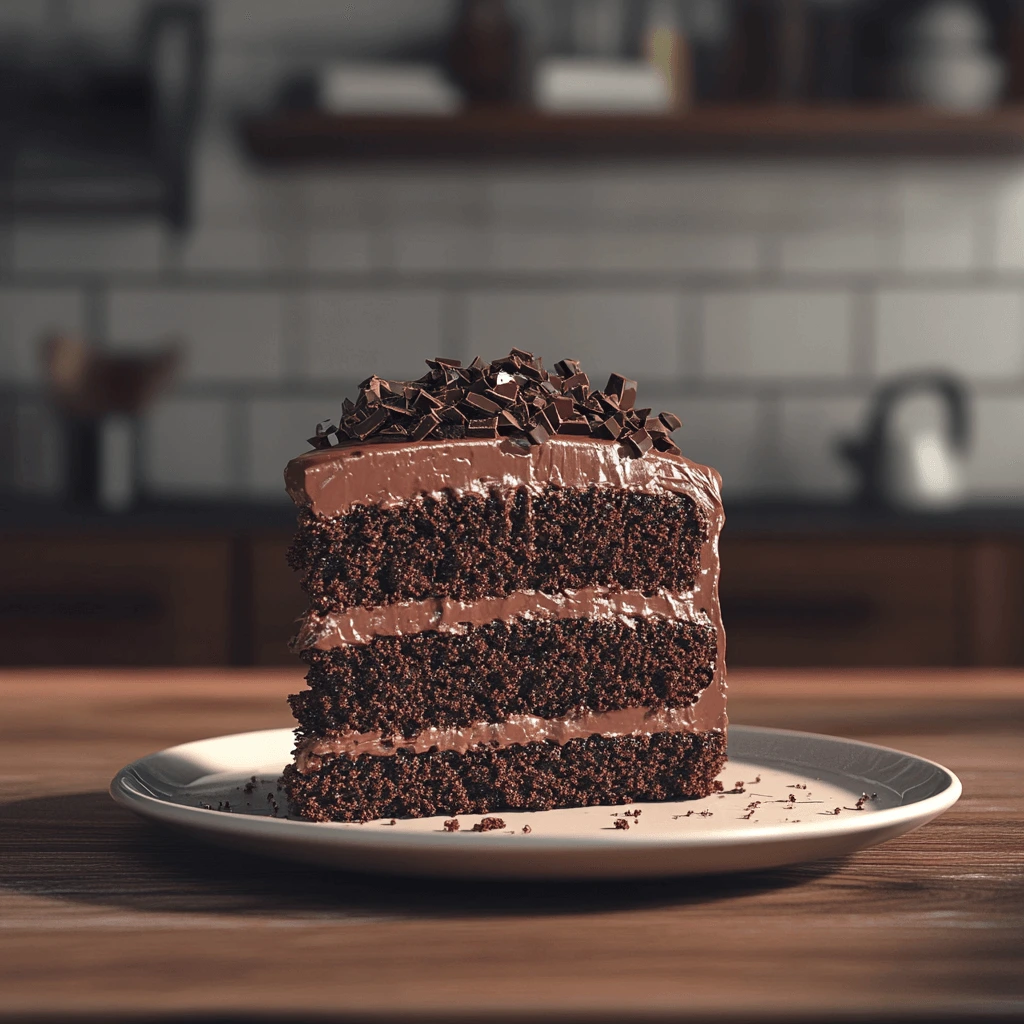
After all the hard work of baking and frosting your chocolate cake, it’s important to store it properly to keep it fresh and moist for as long as possible. Whether you’re serving it the same day or saving it for later, proper storage is essential for maintaining the cake’s texture and flavor. In this section, we’ll discuss how to store your chocolate cake effectively and how to refresh it if it starts to dry out.
How to Store Leftover Cake Without Drying It Out
To keep your chocolate cake moist, it’s important to store it in an airtight container or tightly wrapped in plastic wrap. This helps prevent moisture from escaping and ensures the cake stays fresh. If your cake has frosting, store it in a cake box or cover it loosely with a cake dome to prevent the frosting from becoming smeared.
If you plan to store the cake for several days, you can also refrigerate it. However, it’s important to let the cake come to room temperature before serving, as chilling can slightly alter the texture. To maintain moisture, you can also lightly cover the cake with a damp paper towel inside the container before sealing it.
For cakes that will be stored for longer periods (more than 4 days), freezing is a good option. Wrap the cake tightly in plastic wrap and aluminum foil, or place it in an airtight container, and store it in the freezer. When you’re ready to enjoy it, allow it to thaw at room temperature for a few hours.
How to Refresh a Cake That’s Starting to Dry Out
If your chocolate cake starts to lose moisture over time, there are a few tricks you can use to bring it back to life:
- Simple Syrup: If your cake feels dry, you can brush it with a simple syrup made from equal parts water and sugar. Lightly drizzle the syrup over the cake layers to add moisture without affecting the flavor.
- Microwave with a Damp Paper Towel: If you’re in a rush, you can microwave individual slices of cake. Place a damp paper towel over the cake slice and microwave it for 15-20 seconds. The steam will help rehydrate the cake, making it moist again.
- Frosting Refresher: If the frosting has hardened or separated, you can refresh it by mixing in a bit of milk or cream and reapplying it to the cake. This will add moisture and help restore the cake’s fresh, moist texture.
By following these storage and refreshing tips, you can ensure that your chocolate cake stays moist and delicious for longer.
FAQ Section
What is the secret to moist chocolate cake?
The secret to a moist chocolate cake lies in the right balance of fat-rich ingredients like butter and oil, moisture-retaining elements like sour cream or buttermilk, and proper mixing techniques to avoid overmixing the batter.
What is the secret to super moist cake?
For a super moist cake, using ingredients like oil, sour cream, and buttermilk is key. Additionally, be sure to bake at the correct temperature and avoid overbaking to ensure the cake retains its moisture.
What ingredient makes chocolate cake moist?
Buttermilk, sour cream, and oil are the primary ingredients that contribute to the moistness of a chocolate cake. These ingredients help lock in moisture, keeping the cake soft and tender.
How to make moist chocolate cake at home?
To make a moist chocolate cake at home, use high-quality ingredients like cocoa powder, buttermilk, and oil. Mix the ingredients gently to avoid overworking the batter, and bake at the correct temperature to retain the cake’s moisture.
Conclusion
The best chocolate cake recipe isn’t just about having the right ingredients—it’s about knowing how to balance those ingredients to create the perfect texture and flavor. By focusing on moisture through the use of fats, dairy, and other key ingredients, you can bake a cake that stays moist and tender, with every bite full of rich, chocolaty goodness. Follow the tips outlined in this article, and you’ll be able to create the ultimate chocolate cake that everyone will rave about.
Learn more about how to achieve the perfect cake texture with these expert tips from King Arthur Baking.

